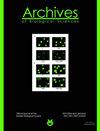丛菌根对辣椒生理生化指标及辣椒素产生的影响:提取方法和溶剂的比较研究
IF 0.8
4区 生物学
Q4 BIOLOGY
引用次数: 0
摘要
本研究采用气相色谱-质谱联用技术,以乙醇(EtOH)、乙酸乙酯(EtAce)和乙腈(AceN)为溶剂,通过磁搅拌和超声辅助提取两种不同的提取方法,研究了两种菌根真菌——mosfuneliformis (Fm)和Rhizophagus intraradices (Ri)对辣椒素产生的影响。研究了菌根真菌对植物生理生化活性、总酚类化合物含量和抗氧化活性的影响。除丙二醛(MDA)外,接种菌根真菌的植株的各项指标均显著高于未接种菌根真菌的对照植株,丙二醛是由于细胞膜损伤引起的脂质过氧化的一种指标。结果表明,与对照相比,接种菌根真菌可使辣椒素和二氢辣椒素的产量增加4倍。结果还表明,超声辅助萃取是气相色谱法测定辣椒素最有效的方法。本文章由计算机程序翻译,如有差异,请以英文原文为准。
The effect of arbuscular mycorrhiza on physiological and biochemical parameters and capsaicinoid production in Capsicum annuum L.: A comparative study of extraction methods and solvents
This study aimed to determine the effect of two mycorrhizal fungi, Funneliformis mosseae (Fm) and Rhizophagus intraradices (Ri), on capsaicinoid production in Capsicum annuum L. by gas chromatography-mass spectrometry (GC-MS) via two different extraction approaches, magnetic stirring and ultrasound-assisted extraction with three different solvents, ethanol (EtOH), ethyl acetate (EtAce), and acetonitrile (AceN). The effect of mycorrhizal fungi on some physiological properties and biochemical activity, the content of total phenolic compounds, and antioxidant activity were also investigated. For all investigated parameters, the plants inoculated with mycorrhizal fungi showed significantly higher values than the non-mycorrhizal control plants, except for malondialdehyde (MDA), which was an indicator of lipid peroxidation due to damage that occurred in the cell membrane. It was concluded that inoculation with mycorrhizal fungi increased both capsaicin and dihydrocapsaicin production up to 4-fold in C. annuum compared to the control. Results also indicated that ultrasoundassisted extraction with EtAce was the most effective method for the determination of capsaicin by GCMS.
求助全文
通过发布文献求助,成功后即可免费获取论文全文。
去求助
来源期刊
CiteScore
1.40
自引率
0.00%
发文量
25
审稿时长
3-8 weeks
期刊介绍:
The Archives of Biological Sciences is a multidisciplinary journal that covers original research in a wide range of subjects in life science, including biology, ecology, human biology and biomedical research.
The Archives of Biological Sciences features articles in genetics, botany and zoology (including higher and lower terrestrial and aquatic plants and animals, prokaryote biology, algology, mycology, entomology, etc.); biological systematics; evolution; biochemistry, molecular and cell biology, including all aspects of normal cell functioning, from embryonic to differentiated tissues and in different pathological states; physiology, including chronobiology, thermal biology, cryobiology; radiobiology; neurobiology; immunology, including human immunology; human biology, including the biological basis of specific human pathologies and disease management.

 求助内容:
求助内容: 应助结果提醒方式:
应助结果提醒方式:


